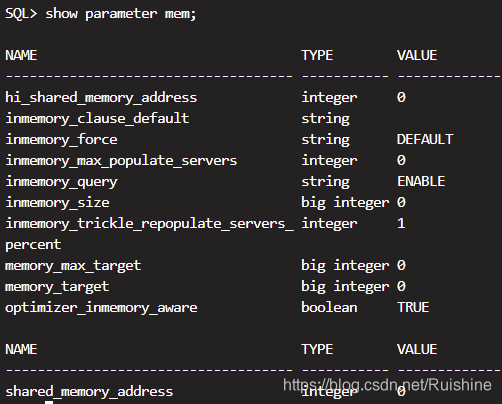Oracle 修改 SGA 大小
本文共 746 字,大约阅读时间需要 2 分钟。
示例:将 SGA 由 2G 修改为 32G
方式一、通过 spfile 修改
1)使用SYS用户以SYSDBA身份登录系统
$ sqlplus / as sysdba
2)查询 memory_target 参数

SQL>alter system set sga_max_size=32G scope=spfile;SQL>alter system set sga_target=32G scope=spfile;
注:alter system set sga_target=1600m scope=spfile;后面必须要加scope=spfile,指定修改Spfile。否则会报“无法修改初始化参数”的错。
4)重启数据库使修改生效
SQL> shutdown immediate;SQL> startup ;
方式二、通过 pfile 参数修改
1)创建 pfile
SQL>create pfile from spfile;
默认存放路径为: $ORACLE_HOME/dbs
2)修改 pfile 内容
$ vi INITorcl.ORA //假设 1)中生成的 pfle 文件名为INITorcl.ORA
修改后主要内容为
sga_target=34359738368(32G)lock_sga=truepga_aggregate_tagert=250000000(250M左右)workarea_size_policy=autopre_page_sga=truesga_max_size=34359738368(32G)
3)用 pfile 启动数据库
SQL>startup pfile='$ORACLE_HOME/dbs/INITorcl.ORA'
转载地址:http://dyqiz.baihongyu.com/
你可能感兴趣的文章
Network Dissection:Quantifying Interpretability of Deep Visual Representations(深层视觉表征的量化解释)
查看>>
Network Sniffer and Connection Analyzer
查看>>
Network 灰鸽宝典【目录】
查看>>
Networkx写入Shape文件
查看>>
NetworkX系列教程(11)-graph和其他数据格式转换
查看>>
Networkx读取军械调查-ITN综合传输网络?/读取GML文件
查看>>
network小学习
查看>>
Netwox网络工具使用详解
查看>>
Net与Flex入门
查看>>
net包之IPConn
查看>>
net发布的dll方法和类显示注释信息(字段说明信息)[图解]
查看>>
Net操作配置文件(Web.config|App.config)通用类
查看>>
NeurIPS(神经信息处理系统大会)-ChatGPT4o作答
查看>>
neuroph轻量级神经网络框架
查看>>
Neutron系列 : Neutron OVS OpenFlow 流表 和 L2 Population(7)
查看>>
NEW DATE()之参数传递
查看>>
New Relic——手机应用app开发达人的福利立即就到啦!
查看>>
new 一个button 然后dispose,最后这个button是null吗???
查看>>
next项目部署到服务器pm2进程守护
查看>>
nexus上传jar
查看>>